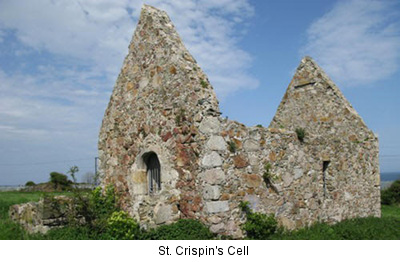Journal Volume 1 1992
Old Greystones and Ancient Rathdown (continued/4)

The 'parish church' mentioned by Wright appears to have been one of a number of chapels listed by Canon Scott of Bray as having belonged to Delgany. Indeed it would seem from what both Wright and Scott say that such a chapel existed as well as and at a short distance from St Crispin's Cell. St Crispin's Cell seems to be post - Reformation but there are indications that there was a settlement of much greater antiquity here. Interestingly, the name Crispin was early adopted as a surname in England and Dr Reaney, the standard authority on British surnames, says it was the name of the patron saint of shoemakers, and that Crispin was martyred at Soissons about the year 285 (16). As to the second and apparently earlier place of worship at Rathdown, Canon Scott was of the opinion that it was the castle chapel, included under the rectory of Delgany (17).
The 'Col. Tarrant' referred to by Wright as having allegedly desecrated Rathdown churchyard has given me some trouble. His name is on Taylor and Skinner's map as occupying Rathdown in 1777. He was there in 1803 (18) and is again mentioned as the beneficial occupier in 1806 (19). But when did he arrive on the scene? And did he leave or did he die? No Tarrant gravestone is recorded in Brian Cantwell's 'Memorials' and I haven't been able to find any Tarrant will. So what became of this officer whose surname and rank only are recorded? We learn from records preserved in the Registry of Deeds in Dublin that Charles Tarrant, a captain in the Corps of Engineers, acquired by deed of assignment from Christopher Plunkett a parcel of land at Rathdown in April 1771 (20) . He also acquired by deed of assignment from George Warren a further parcel of land and a dwelling house in the same townland in November 1774 (21),giving him some forty acres in all, as well as the house. Going through my old volumes of the Irish Sword recently I discovered that Lieutenant-Colonel Charles Tarrant, 'who was major of the company of Royal Engineers in Ireland ...', prepared in 1793 a report, complete with drawing, on Athlone Castle (22). It would be interesting to know where Tarrant, the senior officer of Engineers, was employed during the 1798 insurrection.
In February 1807 Charles Tarrant, 'late of the city of Dublin but then of the city of London in England, esquire, Lieutenant-Colonel of the Engineers ...', assigned by deed to Redmond Boate, surgeon, some property of his in Dublin (23). We needn't pursue Tarrant's career beyond his settlement in London, other then to remark that when he died at an advanced age in 1819 he held the rank of major-general. I should add that his name is miscopied 'Farrant' in the typescript Ordnance Survey Letters prepared at Bray in 1928 (24).


